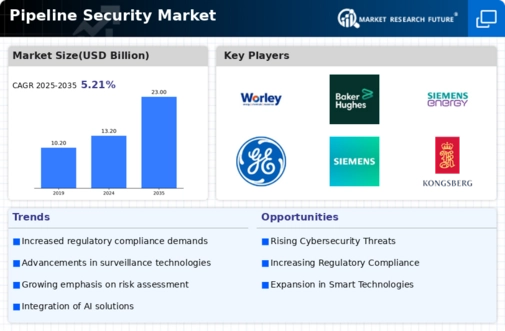Regulatory Pressures and Compliance
The Pipeline Security Market is significantly influenced by stringent regulatory frameworks aimed at ensuring the safety and security of pipeline operations. Governments worldwide are implementing more rigorous compliance standards, which necessitate the adoption of advanced security technologies. In 2025, it is estimated that compliance-related expenditures in the pipeline sector will exceed 15 billion dollars, reflecting the urgency for operators to align with these regulations. This regulatory landscape not only drives investment in security solutions but also fosters innovation as companies seek to develop compliant technologies. Consequently, the Pipeline Security Market is poised for growth as organizations strive to meet these evolving regulatory demands.
Rising Incidents of Pipeline Attacks
The Pipeline Security Market is experiencing heightened demand due to the increasing frequency of pipeline attacks. Recent data indicates that incidents of sabotage and terrorism targeting pipelines have surged, prompting operators to invest in advanced security measures. In 2025, the number of reported attacks has risen by approximately 30 percent compared to previous years. This alarming trend compels stakeholders to prioritize security solutions, thereby driving growth in the Pipeline Security Market. Companies are now more inclined to adopt comprehensive security frameworks that encompass surveillance, monitoring, and rapid response capabilities. As threats evolve, the need for innovative technologies to safeguard critical infrastructure becomes paramount, suggesting a robust future for the Pipeline Security Market.
Growing Awareness of Environmental Impact
The Pipeline Security Market is increasingly shaped by the growing awareness of environmental impacts associated with pipeline operations. Stakeholders are becoming more cognizant of the potential ecological consequences of pipeline breaches, leading to heightened scrutiny and demand for robust security measures. In 2025, it is projected that environmental concerns will drive a 20 percent increase in investments in pipeline security technologies. This trend suggests that companies are not only focusing on immediate security threats but also on long-term sustainability and environmental protection. As a result, the Pipeline Security Market is likely to evolve, integrating environmental considerations into security strategies, thereby enhancing its relevance in contemporary discussions around infrastructure security.
Increased Investment in Infrastructure Security
The Pipeline Security Market is benefiting from a surge in investment aimed at enhancing infrastructure security. As governments and private entities recognize the critical importance of secure pipeline systems, funding for security initiatives has increased substantially. In 2025, it is anticipated that investments in pipeline security will reach approximately 20 billion dollars, reflecting a growing commitment to safeguarding these vital assets. This influx of capital is likely to stimulate innovation and competition within the Pipeline Security Market, as companies strive to offer superior security solutions. The emphasis on infrastructure resilience is expected to drive demand for advanced technologies and services, further propelling market growth.
Technological Advancements in Security Solutions
The Pipeline Security Market is witnessing a transformative phase driven by rapid technological advancements. Innovations such as artificial intelligence, machine learning, and IoT are revolutionizing the way pipeline security is managed. In 2025, the market for AI-driven security solutions is projected to grow by over 25 percent, indicating a shift towards more proactive security measures. These technologies enable real-time monitoring, predictive analytics, and automated threat detection, enhancing the overall security posture of pipeline operators. As the industry embraces these advancements, the Pipeline Security Market is likely to expand, offering new opportunities for vendors and service providers to deliver cutting-edge solutions.

















Leave a Comment